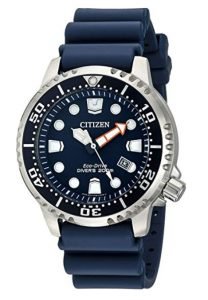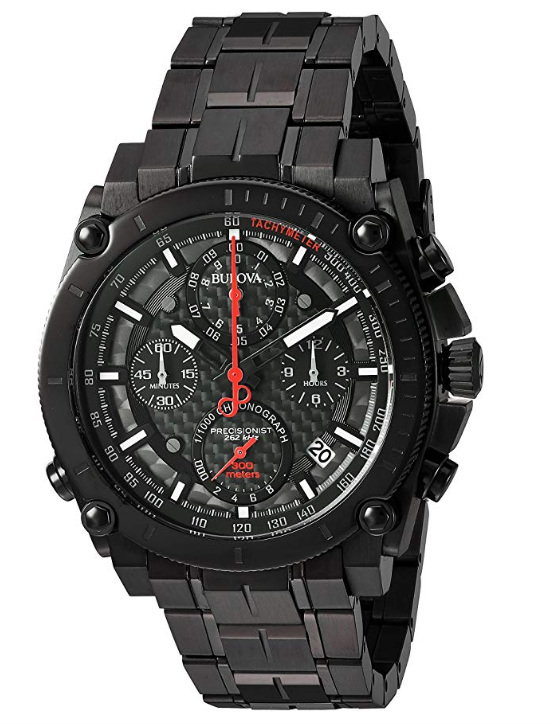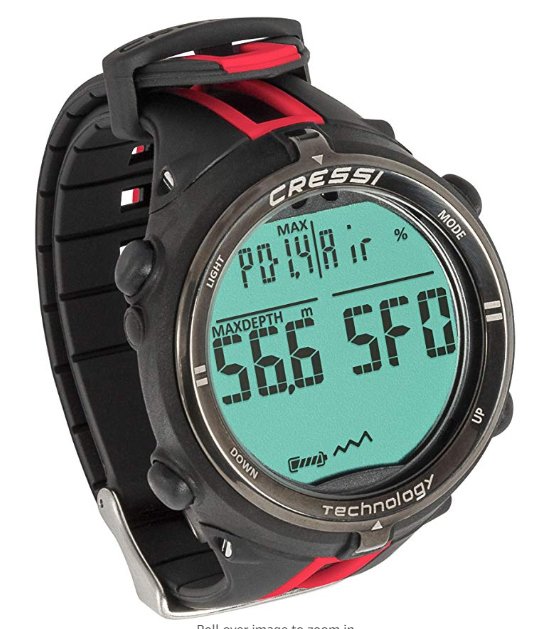Like fins and tanks, watches are necessary for every diver. It helps them time their stay underwater as well as their air consumption. But can you imagine yourself diving with a golden Rolex? What you need is a specific dive watch designed for your underwater needs. Also, fret not, because you can always find the best dive watches under 500. Below, we discussed a comprehensive guide together with 3 best picks from hundreds products we’ve tried.
| DIVE WATCH | BRAND | EXPERT RATING | CHECK PRICE |
|---|---|---|---|
 | Citizen Men’s Promaster Professional Diver Watch | Check Price | |
 | Bulova Men’s Precisionist Dive Watch | Check Price | |
 | Cressi Newton Wrist Computer | Check Price |
What is a dive watch?
Just like any other wristwatches, dive watches are intended to project the time. Most importantly, it allows divers to time their journey, manage their air supply, and determine if it’s time to ascend.
During the 1970s, underwater explorer Jacques Yves Cousteau helped design a watch with luminous markers and one that can endure the pressure of underwater environments. With this, watches for diving are born.
Unlike typical wristwatches, they come with special functions and features. It’s usually bulkier with a rotating bezel and a set of controls. Modern dive watches have built-in barometers and other complicated functions.
Even if you already have a dive timer, it serves as a backup in case the gear bogs down. Aside from that, you can also wear the watch casually for other sports and activities.
Tests that dive watches go through
**Depth and pressure testing
Since they are designed for water immersion, it needs to be water resistant and bears a specific depth rate. In addition, it should have at least 100 meters of depth rating to be considered suitable for underwater activities.
According to PADI, professional divers watches should have at least a depth rating of 300 meters. Below, we reviewed the Bulova Dive Watch, which is perfect for professional divers out there.
To test it for pressure resistance, a hot-plate condensation test will be performed first to ensure that no moisture is present inside the watch. After that, the watch will be placed inside a pressure tester under 125% of the applied depth rating.
Two hours after, the diver’s watch will be depressurized within one minute under 3 meters of equivalent pressure. It will be subjected to this pressure for an hour before performing another hot-plate condensation test.
**Temperature testing
Meanwhile, there’s also the ISO 6425 certification, which rates watches and determines if it’s suitable for scuba diving purposes.
This certification also incorporates the ISO 764, a certification governing antimagnetic timepieces. Also, it includes ISO 1413, which regulates the shock resistance of the watch. Aside from the physical shock of dropping, diving watches should also endure thermal shock.
They should be resistant enough to endure hot water immersion of up to 104F as well as cold water immersion of 41F. To test for thermal shock, it will be immersed in these temperatures for at least 10 minutes. After the immersion, a hot-plate condensation test will be performed to ensure that no moisture has seeped through the watch.
If the dive watch endures the mentioned tests, it will pass the ISO 6425 certification.
Digital vs. analog watch
There are two options: the analog type or the digital one.
Analog dive watches are common as it allows the diver to monitor the time without too much fuss. Also, some of them have automatic technology, so there’s no need to replace batteries. This watch also uses a unidirectional bezel to monitor elapsed time and to serve as a countdown timer for the diver.
Depending on the model, an analog watch comes with other built-in features like a tachymeter, no-decompression dive table on the band, barometer, and so on. Moreover, analog dive watches are low maintenance and can be worn casually for other activities like biking, hiking, swimming, and more.
On the other hand, digital dive watches, also known as wrist computers, are becoming a trend. It’s a battery-powered gadget that displays the elapsed time automatically. It also comes with tons of functionalities that you can’t find on a standard chronograph watch.
Also, wrist computers can save your dive statistics and sync it to an app. This way, you can easily record your journey without using another gear.
So what’s the best choice? It depends on your personal preference. Analog diving watches are straightforward and available at affordable price ranges. Meanwhile, digital diving watches offer more features, but it also comes with a hefty price tag and you have to master the ins and outs of the program.
What type of movement should you get?
There are three major clock movements: Quartz, Mechanical, and Automatic. These movements are responsible for the ticking motion of the clock, which is why it’s called as the heart of a watch.
The question is, which one should you get? Here’s a quick look at each one:
**Quartz movement – Quartz is battery powered on which the second hand moves in individual ticks. So far, Quartz is the most common clock movement which can be found on a range of wristwatches and wall clocks. It’s also cheaper than the two other types.
NOTE: The so-called Japanese movement is a type of Quartz movement.
**Mechanical movement – In this movement, the second hand moves smoothly and in a sweeping motion. You need to wind the watch manually to work.
**Automatic movement – With this type, the arms move automatically through kinetic energy transfer from your wrist. The mechanism will be driven to work automatically to operate without a battery. If you want a low maintenance dive watch, the one with an automatic movement might be ideal.
Prices
Professional divers watches don’t come cheap. If money isn’t an issue, it can be as expensive as $5,000 or more. For recreational divers, a watch worth around $200 to $500 should be fine.
Nevertheless, you can also find great dive watches under $500. Below, we reviewed a timepiece suitable for professional diving without the need to break the bank.
3 Best Dive Watches Under 500 Reviewed
#1 CHOICE
OUR TOP PICK: Citizen Men’s Eco Drive Promaster Diver Watch

Product Name: Citizen Men’s Promaster Professional Diver Watch
Product Description: If you’re looking for a trusty recreational dive watch, consider getting the Citizen Eco Drive Promaster Diver Watch. It’s depth rated at 660 feet or roughly 200 meters. Moreover, it has a Japanese Quartz movement with an analog display encased in a 44 mm diameter case that is stainless steel . In addition, this dive watch has a date window at 4 o’clock as well as a blue dial and a unidirectional bezel. Moreover, it has an anti-reflective mineral crystal that makes it easy to read. The display is secured with a 10-inch molded polyurethane band paired with buckle closure.
- Water Resistance
- Functionality
- Value for Money
- Aesthetics
Overall
Summary
The best thing about this dive watch is its Eco-Drive technology. Although it uses movement Quartz, this proprietary technology uses light, so the watch doesn’t need a battery anymore.
Overall, this is a well-built dive watch that you can wear casually. Remember that it’s normal for the clock to arrive without ticking. Just expose it to ambient light and it will start working in a few minutes.
Pros
✔️Eco-Drive technology, no need for a battery
✔️Unidirectional rotating bezel
✔️No-decompression table on the band
Cons
❌Some people don’t like the painted bezel
RUNNERS-UP: Bulova Men’s Precisionist Dive Watch

For professional divers, our top recommendation is the Bulova Men’s Precisionist Dive Watch. It has chronograph functions with 12-hour subdials, date window between 4:00 and 5:00, and a precise movement with a 262 kHz frequency.
Most of all, this rugged watch for diving has a depth rating of 300 meters. With that, you can take this gear in deep dives or technical dives. It’s also equipped with a luminous tachymeter, black carbon fiber dial, and black ion plated stainless steel case (45 mm diameter).
In addition, it has a Japanese Quartz movement. It boasts its precision and measurement with its intricate design and system.
Although the Bulova Dive Watch has a large display, it’s lightweight at 8.8 ounces, together with a stationary bezel. Just take note that this is a battery-powered watch that will require replacements sooner or later.
Cressi Newton Wrist Computer

If a digital dive watch is what you’re looking for, you should check out the Cressi Newton Wrist Computer. It’s designed and produced by Cressi, a pioneer in diving gears. It’s equipped with the dual-mixture Cressi-Wienke RGBM algorithm. This helps calculate safe decompression, even on multi-dive days.
Moreover, it can handle two different hyperoxygenated mixtures that you can easily set. For added safety, this watch has a graphic CNS oxygen toxicity indicator. Overall, it offers complete processing of dive data for each dive, regardless if you use air or nitrox. Also, this trusty watch can log up to 70 hours of dive records.
Among other features of this Cressi Newton Wrist Computer are gas switching during dive, 4-button interface, and a Fo2 and Po2 adjustable settings.
The powerful system of this watch comes in stainless steel, anti-shock case. Although it’s tough on underwater environments, it remains lightweight and comfy to wear.
What to look for in the best dive watch under 500
Make sure that you check for the following aspects:
-Water resistance
If there’s one defining factor for a dive watch, it would be its water resistance. Measured as depth rating, they should have at least a water resistance of 100 meters. Meanwhile, for professional dive watches, 300 meters is the requirement.
Usually, some budget-friendly underwater watches have a depth rating of 200 meter water resistance. This is ideal for recreational diving, snorkeling, and other underwater activities.
However, deep and technical divers need a higher depth rating. This is where 300 meters of water resistance becomes necessary.
Remember that the bigger the depth rating is, the more expensive the watch gets.
-Functionalities
The basic features should include a decent depth rating and elapsed time bezel or digital projection. Also, it should have a long and adjustable strap to suit various wrist sizes.
Moreover, it should be multifunction, aside from letting the diver know the time. If you’re looking for a feature-packed timepiece, you should invest in a digital model. Some wrist computers have tide predictors, log capabilities, thermometers, depth gauges, electronic compasses, and so on.
-Battery power
If you’re investing in a quartz movement, you should check the battery power reserve of the watch. This way, you can make dozens of dives before needing a replacement.
-Readability
The watch should be readable even under harsh underwater conditions. Always look for luminescent dials and components. This way, you can manipulate it even if you’re diving at night. This feature is useful when you’re underwater and when the watch is in use in the dark.
-Material
Never purchase a timepiece marketed as a dive watch if it has a metal strap. They should always have rubber straps that can adjust in the thermal changes underwater. Nevertheless, this will boil down to your personal preference.
Moreover, look for a product with a non-corrosive material, especially if you’re diving regularly on saltwater. This is also the same reason why it’s better to purchase a diving watch with rubber bands.
-Size
The size is a matter of what suits your wrist and the readability of the display. Nevertheless, it shouldn’t be too large that the lugs are protruding from your wrist. Aside from being unsightly, oversized dive watches may get tangled with your other gears or even underwater elements.
-Rotating bezel
A rotating bezel is a must for analog watches. It’s useful for every dive as it allows them to track elapsed time underwater. Also, it can be used as a timer should the diver need to ascend within a short period of time. Unlike wrist computers, a rotating bezel is purely mechanical and doesn’t require extra battery power to work.
-Hardened mineral glass face
You should always get one with hardened mineral crystal to endure deeper dives. Some would have a scratch resistant sapphire crystal, which can last for a decent depth. However, if you’re looking for the most durable and long-lasting choice, invest in one with harder minerals.
-Accuracy
A watch should always be accurate as the diver’s safety is at stake in its performance. So before taking your new watch to a dive, make sure that you have checked its accuracy. For mechanical and automatic watches, it’s best to check the accuracy of the time as some tend to lose between 1 and 5 seconds a week.
Frequently Asked Questions
Q: How do I know if my watch is too big?
A: Well, there’s no standard size as to what type you use. You can quickly check if it’s too big if it looks massive on your wrist. The lugs of your dive watch shouldn’t go past your wrist. If it does, you should look for a smaller one.
Q: What watches do Navy SEALs wear?
A: The Navy SEALs are known for wearing G Shock dive watches, although they can also be seen wearing brands like Casio and Suunto. However, there’s no standard brand that the Navy SEALs have to use. It’s actually a personal choice of the diver.
Q: On what hand should I wear it?
A: Most dive watches have a screw down crown on the right hand side for easy winding. But if you’re left-handed, you can wear the watch on your left wrist, but you should master tweaking it with your right hand.
Q: Why does a diver’s watch have rotating bezels?
A: Analog dive watch come with a rotating bezel to serve as a timer of elapsed time. This is crucial for divers, especially those who are diving with minimal air supply. Also, it helps divers calculate the length of the dive and when they are supposed to ascend.
Q: Should I wear a dive watch?
A: For deep dives or technical dives, it’s usually advisable to wear durable watch. This way, the diver can time his or her journey. It also helps divers manage their air supply.
Final words
The best dive watches under 500 dollars will help you improve your dives without breaking the bank. Above, we reviewed three of the best options you can try. The Citizen Eco Drive Diver Watch is great value for money with its features and functions. Nevertheless, the Bulova Dive Watch is also a great choice, with its tough and rugged build.
For those who are looking for a digital dive watch, the Cressi Wrist Computer is an unbeatable option. It’s feature-packed and provides advanced tools for every diver. What do you think of our picks here? Have you tried any of it during your dive? Let us know in the comment section!
